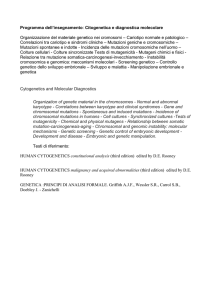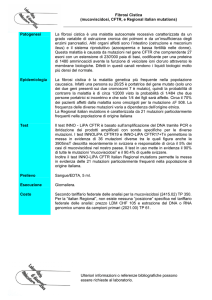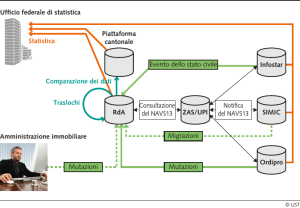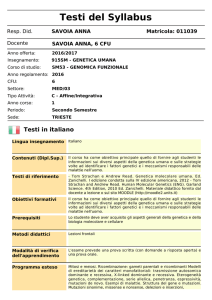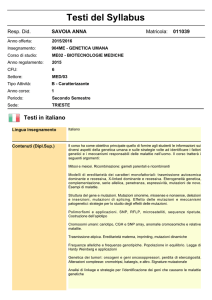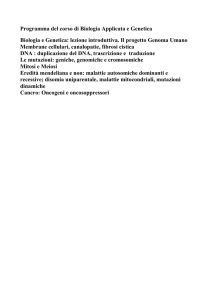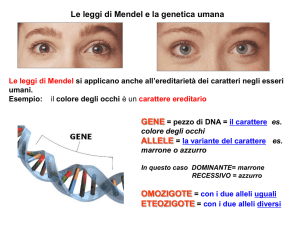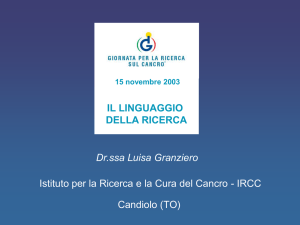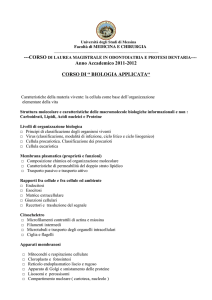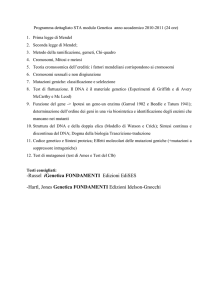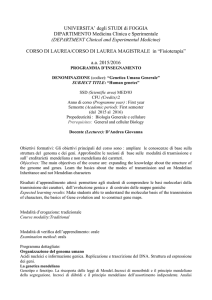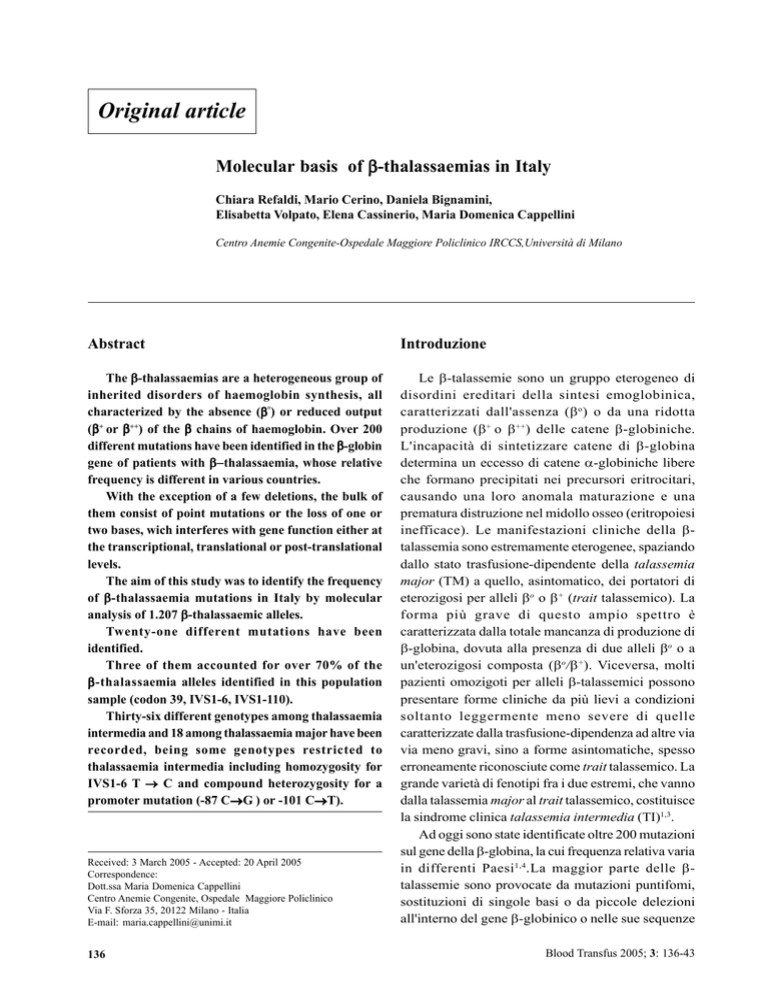
Original article
Molecular basis of β-thalassaemias in Italy
Chiara Refaldi, Mario Cerino, Daniela Bignamini,
Elisabetta Volpato, Elena Cassinerio, Maria Domenica Cappellini
Centro Anemie Congenite-Ospedale Maggiore Policlinico IRCCS,Università di Milano
Abstract
Introduzione
The β-thalassaemias are a heterogeneous group of
inherited disorders of haemoglobin synthesis, all
β°) or reduced output
characterized by the absence (β
+
++
β or β ) of the β chains of haemoglobin. Over 200
(β
different mutations have been identified in the β-globin
gene of patients with β−
β−thalassaemia, whose relative
frequency is different in various countries.
With the exception of a few deletions, the bulk of
them consist of point mutations or the loss of one or
two bases, wich interferes with gene function either at
the transcriptional, translational or post-translational
levels.
The aim of this study was to identify the frequency
of β -thalassaemia mutations in Italy by molecular
analysis of 1.207 β-thalassaemic alleles.
Twenty-one different mutations have been
identified.
Three of them accounted for over 70% of the
β -thalassaemia alleles identified in this population
sample (codon 39, IVS1-6, IVS1-110).
Thirty-six different genotypes among thalassaemia
intermedia and 18 among thalassaemia major have been
recorded, being some genotypes restricted to
thalassaemia intermedia including homozygosity for
IVS1-6 T → C and compound heterozygosity for a
→G ) or -101 C→
→T).
promoter mutation (-87 C→
Le β-talassemie sono un gruppo eterogeneo di
disordini ereditari della sintesi emoglobinica,
caratterizzati dall'assenza (β o ) o da una ridotta
produzione (β+ o β ++) delle catene β-globiniche.
L'incapacità di sintetizzare catene di β-globina
determina un eccesso di catene α-globiniche libere
che formano precipitati nei precursori eritrocitari,
causando una loro anomala maturazione e una
prematura distruzione nel midollo osseo (eritropoiesi
inefficace). Le manifestazioni cliniche della βtalassemia sono estremamente eterogenee, spaziando
dallo stato trasfusione-dipendente della talassemia
major (TM) a quello, asintomatico, dei portatori di
eterozigosi per alleli βo o β+ (trait talassemico). La
forma più grave di questo ampio spettro è
caratterizzata dalla totale mancanza di produzione di
β-globina, dovuta alla presenza di due alleli βo o a
un'eterozigosi composta (βo/β+). Viceversa, molti
pazienti omozigoti per alleli β-talassemici possono
presentare forme cliniche da più lievi a condizioni
soltanto leggermente meno severe di quelle
caratterizzate dalla trasfusione-dipendenza ad altre via
via meno gravi, sino a forme asintomatiche, spesso
erroneamente riconosciute come trait talassemico. La
grande varietà di fenotipi fra i due estremi, che vanno
dalla talassemia major al trait talassemico, costituisce
la sindrome clinica talassemia intermedia (TI)1,3.
Ad oggi sono state identificate oltre 200 mutazioni
sul gene della β-globina, la cui frequenza relativa varia
in differenti Paesi 1,4.La maggior parte delle βtalassemie sono provocate da mutazioni puntifomi,
sostituzioni di singole basi o da piccole delezioni
all'interno del gene β-globinico o nelle sue sequenze
Received: 3 March 2005 - Accepted: 20 April 2005
Correspondence:
Dott.ssa Maria Domenica Cappellini
Centro Anemie Congenite, Ospedale Maggiore Policlinico
Via F. Sforza 35, 20122 Milano - Italia
E-mail: [email protected]
136
Blood Transfus 2005; 3: 136-43
Molecular basis of β-thalassaemias
Introduction
The β-thalassaemias are a heterogeneous group of
inherited disorders of haemoglobin synthesis, all
characterized by the absence (β°) or reduced output
(β+ or β++) of the β chains of haemoglobin.
The inability to synthesize β-globin chains results
in an excess of α-globin chains that precipitate in red
cell precursors and cause abnormal cell maturation
and their premature destruction in the bone marrow
(ineffective erythropoiesis).
Red cells that survive to reach the peripheral
circulation are prematurely destroyed in the spleen.
The clinical manifestations of β-thalassaemia are
extremely diverse, spanning a broad sprectum from
the transfusion-dependent state of thalassaemia major
(TM) to the asymptomatic state of heterozygous
carrier for β° or β+ (thalassaemia trait).
The most severe end of the spectrum is
characterized by the complete absence of β globin
production and results from the inheritance of two β°
thalassaemia alleles, homozygous or compound
heterozygous states (rarely β°/β+).
Conversely, many patients who have inherited two
β-thalassaemia alleles may have a milder disease,
ranging from a condition that is only slightly less
severe than transfusion dependence through a
spectrum of decreasing severity to one that is
asymptomatic and often mistaken as β-thalassaemia
trait.
This extremely different collection of phenotypes
between the two extremes of thalassaemia major and
thalassaemia trait constituites the clinical syndrome of
thalassaemia intermedia (TI)1-3.
Over 200 different mutations have been
identified in the β-globin gene of patients with
β-thalassaemia, whose relative frequency is different
in various countries1,4. With the exception of a few
deletions, the bulk of them consist of point mutations
or the loss of one or two bases, wich interferes with
gene function either at the transcriptional, translational
or post-translational levels.
Mutations affecting transcription can either involve
the conserved DNA sequences that form the β globin
promoter or the stretch of 50 nucleotides in the 5'UTR.
Generally they result in a mild to minimal deficit
of β globin output that reflects the relatively mild
phenotype of these β+ thalassaemias. Some of these
mutations in the promoter cause an extremely mild
Blood Transfus 2005; 3: 136-43
fiancheggianti. Queste mutazioni agiscono su ognuna
delle fasi del processo di espressione genica:
trascrizione del gene, maturazione del pre-mRNA,
traduzione dell'mRNA. I difetti di trascrizione
coinvolgono le sequenze del DNA conservato che
formano il promotore (promoter): queste mutazioni
diminuiscono la quantità di mRNA della β-globina
dal 10% al 20% rispetto ai livelli normali, dando
origine a un fenotipo lieve di β-talassemia (β+). Alcune
di queste mutazioni determinano un deficit
estremamente ridotto della β-globina, del tutto
"silente" nei soggetti eterozigoti, che presentano un
livello normale di HbA2 e normali indici eritrocitari1.
Le mutazioni silenti (β ++) vengono, di norma,
individuate negli stati di eterozigosi composta con un
allele β-talassemico grave, determinando una forma
di talassemia intermedia, oppure in soggetti omozigoti
con fenotipo tipico del trait talassemico. Gli alleli
silenti non sono comuni, ad eccezione della mutazione
–101 C→T, che riguarda un notevole numero delle
forme più lievi di β-talassemia nell'area
mediterranea5,6. Mutazioni che alterano il processo di
maturazione del pre-mRNA (splicing) possono
coinvolgere i dinucleotidi invarianti GT del sito
donatore e AG del sito accettore di splicing, posti
rispettivamente agli estremi 5' e 3' delle sequenze
introniche: in questo caso, il normale splicing viene
totalmente abolito e si genera un fenotipo β otalassemico. Le mutazioni localizzate all'interno delle
sequenze "consenso" molto conservate, poste vicino
ai siti donatore e accettore, riducono l'efficienza di
splicing e producono un fenotipo β+-talassemico con
forme cliniche da lievi a severe. Le mutazioni
all'interno di introni ed esoni potrebbero anche alterare
gli schemi di splicing dell'RNA pre-messaggero (premRNA). Le mutazioni che aboliscono la traduzione
dell'mRNA, sia all'inizio sia nella fase attiva della
sintesi globinica, si associano tutte al fenotipo βo. In
rare famiglie sono state descritte alcune mutazioni di
β-talassemia che segregano indipendentemente dal
cluster genico della β-globina: in questi casi sono
coinvolti fattori regolatori della trascrizione7.
Scopo di questo studio è quello di identificare la
frequenza, in Italia, di tali mutazioni, mediante l'analisi
molecolare di 1.207 alleli β-talassemici.
Pazienti e metodi
Sono state condotte analisi sul DNA di 817 soggetti
137
C Refaldi et al.
Table I - Sequence and positions of primers used to detect different beta-thalassaemia mutations
Primer
IA-forward
IA-reverse
IB-forward
IB-reverse
II-forward
II-reverse
IIIA-forward
IIIA-reverse
IIB-forward
IIB-reverse
IIIC-forward
IIIC-reverse
IV-forward
IV-reverse
V-forward
V-reverse
VI-forward
VI-reverse
Position
-129→-104
Exon 1 codons 21→17
-123→-104
Esone 1 codons 21→17
-123→-104
IVS1(nt 119→101)
IVS1(nt 29→48)
IVS2(nt 30→11)
IVS1(nt 101→120)
Exon 2 codons 74→68
IVS1(nt 101→120)
IVS2(nt 30→11)
IVS2(nt 684→703)
Exon 3 codons 132→125
IVS2(nt 457→476)
Exon 3 codons 114→108
Exon 3 codons 114→120
nt 60→40 3’ polyA
Sequence 5’→3’
GTACGGCTGTCATCACTTAGACCTCA
(GC)45-CAACTTCATCCACGTTCACC
(GC)40-CTGTCATCACTTAGACCTCA
CAACTTCATCCACGTTCACC
(GC)45-CAACTTCATCCACGTTCACC
AAAATAGACCAATAGGCAG
AAGGAGACCAATAGAAACTG
(GC)45-AGAAAACATCAAGGGTCCCA
(GC)40-CTGCCTATTGGTCTATTTTC
GCCATCACTAAAGGCACCG
(GC)40-CTGCCTATTGGTCTATTTTC
AGAAAACATCAAGGGTCCCA
CTGCATATAAATTGTAACTG
(GC)45-TCTGATAGGCAGCCTGCACT
GTGTACACATATTGACCAAA
AGCACACAGACCAGCACGTT
CTGGCCCATCACTTTGGCAA
CACTGACCTCCCACATTCCC
deficit of β-globin, that it is "silent" in heterozygotes,
who have normal HbA2 levels and normal red cells
indices1.
The "silent" mutations are normally identified in
the compounds heterozygous states with a severe βthalassaemia allele, which results in thalassaemia
intermedia, or in homozygotes who have a typical
phenotype of β-thalassaemia trait.
The silent alleles are not common, except for the –
101 C→T, which accounts for a large number of the
milder forms of β-thalassaemia in the Mediterranean5,6.
Mutations that affect RNA processing can involve either
of the invariant dinucleotides (GT at 5' and AG at 3') in
the splice junction in which case normal splicing is
completely abolished with the resulting phenotype of
β°-thalassaemia.
Mutations within the consensus sequences at the
splice junctions reduce the efficiency of normal
splicing to varying degrees and produce a β +
phenotype that ranges from mild to severe.
Mutations within introns and exons might also
affect the splicing pattern of the pre-mRNAs.
Mutations that abrogate mRNA translation either at
the initiation or extension phases of globin synthesis
are all associated with a β°-phenotype.
A few β-thalassaemia mutations that segregate
indipendently of the β-globin cluster have been
described in several families; in such cases, transacting regulatory factors have been implicated7.
The aim of this study was to identify the frequency
of β-thalassaemia mutations in Italy by molecular
analysis of 1,207 β-thalassaemic alleles.
138
italiani, senza rapporti di parentela, che presentavano
situazioni differenti di β-talassemia (146 con
talassemia major, 244 con talassemia intermedia e 427
con trait talassemico), per un totale di 1.207 alleli
esaminati. I pazienti con forme clinicamente
importanti (talassemia major o talassemia intermedia)
sono stati seguiti regolarmente presso il Centro
Anemie Congenite dell'Ospedale Maggiore
Policlinico di Milano. I portatori di trait si erano rivolti
all'ambulatorio del Centro o per consulenza genetica
o per diagnosi, a causa di una modesta anemia. Tutti i
soggetti erano italiani e, date le loro differenti origini
regionali, possono essere ritenuti un campione
rappresentativo della popolazione nazionale. Questo
studio ha ottenuto l'approvazione dal Comitato Etico
dell'Università di Milano e i pazienti hanno dato il
loro consenso informato. A ogni soggetto sono stati
prelevati da 2 a 5 mL di sangue in EDTA.
Analisi del DNA
Il DNA è stato purificato mediante estrazione con
fenolo/cloroformio/alcool isoamilico e precipitazione
con etanolo. Le regioni codificanti e non codificanti
del gene β-globinico sono state amplificate mediante
PCR (Polymerase Chain Reaction) in nove differenti
frammenti (IA, IB, II, IIIA, IIIB, IIIC, IV, V e VI), in
parte sovrapposti e di lunghezza compresa tra 202 e
424 paia di basi. In tabella I sono riportate le sequenze
e le posizioni degli oligonucleotidi sintetici (primers),
specifici per ogni frammento e utilizzati per
evidenziare le diverse mutazioni β-talassemiche.
Blood Transfus 2005; 3: 136-43
Molecular basis of β-thalassaemias
Patients and methods
A total number of 1,207 alleles from 817
(389M/428F) unrelated Italian subjects with
different β-thalassaemia conditions (146 with
Thalassaemia Major, 244 with Thalassaemia
Intermedia and 427 with Thalassaemia trait) have been
analyzed. The subjects with the relevant clinical
phenotypes (Thalassaemia Major and Thalassaemia
Intermedia) are regularly followed at the Centro
Anemie Congenite of Maggiore Policlinico Hospital
in Milan; the carriers of thalassaemic trait have
attended the outpatients clinic of the Centre for genetic
counselling or for diagnosis because of a mild
anaemia. All the subjects were of Italian ancestry and
because of their family different regional origin, they
are a representative sample of the Italian population.
Ethical approval for this study was obtained from the
Ethical Commettee of the University of Milan and
patients were given their informed consent. Two to
five mL of blood was collected in EDTA from each
patient.
DNA analysis
DNA was prepared from white blood cells by
phenol-chloroform isoamyl alcohol extraction and
ethanol precipitation.
All coding and noncoding regions of β-globin gene
were amplified by polymerase chain reaction (PCR)
in 9 different fragments (IA, IB, II, IIIA, IIIB, IIIC,
IV, V, IV) ranging from 202 bp to 424 bp and partially
overlapped.
In table I are reported the sequences and positions
of primers used to detect the different β-thalassaemia
mutations. PCR was conducted in presence of
genomic DNA (100-500ng), 20 pmoles of each
primer, 0.2 mM dNTPs, 1.5mM MgCl, and 1.5 U of
DNA polymerase (Bioline, London, UK) in a final
volume of 50µL containing 16 mM (NH4)2SO4, 67
mM Tris-HCl (pH 8.8, 25 °C) and 0.01% Tween-20.
To improve the sensitivity of the analysis a GC-rich
sequence of 40-45 nucleotides was added to one of
the two primers.
The PCR conditions included an initial
denaturation step at 94 °C for 5 min followed by 35
cycles of 30 sec at 94 °C, 30 sec at 55 (IA, II, IIIB,
IIIC, IIIA, IB) or 56 °C (IV, V, VI), 1min at 72 °C.
A final step at 94 °C for 10 min followed by 30 min at
56 °C was added to improve heteroduplex formation.
Blood Transfus 2005; 3: 136-43
La PCR è stata eseguita in presenza di DNA
genomico (100-500ng), 20 pmoli di ciascun primer,
0,2 mM di dNTP (desossiNucleotideTriFosfato), 1,5
mM di MgCl e 1,5 U di DNA Taq polimerasi (Bioline,
London, UK) per un volume finale di 50µL,
contenenti 16 mM di (NH4)2SO4, 67 mM di Tris-HCl
(pH8,8 a 25 °C) e 0,01% di Tween-20. Per migliorare
la sensibilità dell'esame, è stata aggiunta all'estremità
5' di uno dei due primers una sequenza ricca in GC di
40-45 nucleotidi.
La reazione di PCR prevedeva una fase di
denaturazione iniziale a 94 °C per 5', seguita da 35
cicli di 30" a 94 °C, 30" a 55 (IA, IB, II, IIIB, IIIC,
IIIA) o a 56 °C (IV, V, VI), 1' a 72 °C. Per migliorare
la formazione di eteroduplex, si è aggiunta una fase
finale a 94 °C per 10', seguita da 30' a 56 °C.
Analisi in elettroforesi
Tutti i frammenti amplificati sono stati analizzati
tramite DGGE (Denaturing Gradient Gel
Electrophoresis), utilizzando un apparecchio DcodeTM (Bio-Rad, Hercules, CA, USA).
La migrazione elettroforetica dei campioni è stata
condotta su un gel di poliacrilamide con gradiente
denaturante (il 100% di denaturazione corrisponde a
7 M di urea e al 40% di formamide deionizzata) in
associazione con un gradiente di poliacrilamide (da
6,5 a 12% con rapporto acrilamide:bisacrilamide
39 a 1) insieme a un controllo normale per il gene
β-globinico.
Il gradiente denaturante utilizzato era specifico per
ogni frammento ottenuto in PCR 8 . La corsa
elettroforetica è stata effettuata di notte a 60 volt
costanti e a 60 °C in un tampone Tris-Acetato-EDTA
1x, pH 7,4.
Le bande ottenute sono state visualizzate mediante
colorazione con sali di argento9. Le seguenti mutazioni
sono state individuate direttamente dai quadri di
migrazione specifica: CD 39 C→T, IVS1-6 T→C,
IVS1–110 G→A, IVS1–1 G→A, IVS2–745 C→G, –
101 C→T, –87 C→G, IVS2–1 G→A, CD 6 –A, CD44
–C e CD8 –AA.
I frammenti che dimostravano quadri di
migrazione alterati sono stati sottoposti al
sequenziamento fluorescente diretto di entrambi i
filamenti del DNA, utilizzando il sequenziatore
automatico AbiPrism 310 Genetic Analizer (Applied
BioSystems, Foster City, CA, USA).
139
C Refaldi et al.
Risultati
Table II - Beta-thalassaemia mutations
Mutations
Alleles
n°
Frequency
(%)
β0
β+
β+
β0
β+
β+
β+
β0
β0
β0
β0
β+
β+
β+
β0
β0
β+
β0
β0
β+
β0
494
211
195
77
47
39
37
37
29
8
6
6
5
5
3
2
2
1
1
1
1
1,207
40.93
17.48
16.16
6.38
3.90
3.23
3.06
3.06
2.40
0.66
0.50
0.50
0.41
0.41
0.25
0.16
0.16
0.08
0.08
0.08
0.08
100
CD 39 C→T
IVS1-6 T→C
IVS1-110 G→A
IVS1-1 G→A
IVS2-745 C→G
-101 C→T
-87 C→G
IVS2-1 G→A
CD 6 –A
CD 44 –C
CD 30 G→C
IVS2-844 C→G
+1570 T→C
Hb Lepore
CD 8 –AA
CD 5 –CT
IVS1-5 G→C
ATG>ATA
IVS1-1 G→T
IVS1-843 T→G
IVS1-2 T→A
Total
DGGE analysis
Twenty microliters of all amplified products were
submitted to denaturing gradient gel electrophoresis
(DGGE) by using a D-CodeTM apparatus (Bio-Rad,
Hercules, CA, USA). DGGE was performed on a
linearly increased denaturing gradient (100%
denaturant corresponds to 7 M urea and 40%
deionized formamide) in association to an increased
gradient of polyacrylamide gel (6.5%-12%
polyacrylamide, acrylamide: bisacrylamide ratio
39:1) along side with a normal β-globin control
sample.
The range of denaturing gradient was specific for
each PCR fragments8. Gels were run overnight at
constant 60 volts at 60 °C in TAE buffer 1x pH 7.4.
The bands were visualized by silver staining9.
The following mutations were directly detected by
specific migration patterns: CD 39 C→T, IVS1-6
T→C, IVS1-110 G→A, IVS1-1 G→A, IVS2-745
C→G, -101 C→T, -87 C→G, IVS2-1 G→A, CD 6 –
A, CD 44 –C and CD 8 –AA.
Fragments showing different migration patterns
were submitted to fluorescent automated direct
sequencing on both DNA strands by AbiPrism 310
Genetic Analyzer (Applied BioSystems, Foster City,
CA, USA).
140
Le frequenze delle mutazioni del gene della βglobina riscontrate sono sintetizzate in tabella II. Sono
state identificate 21 diverse mutazioni. Tre di queste
costituiscono circa il 70% degli alleli studiate in questo
campione di popolazione.
La sostituzione C→T a livello del codone 39 è la
mutazione più comune (40,93%); la seconda è IVS1–
6 (T→C) (17,48%) seguita da IVS1–110 (G→A)
(16,16%). Sei mutazioni avevano una frequenza
inferiore al 10%: IVS1–1 (G→A), IVS2–745 (C→G),
–101 (C→T), –87 (C→G) e IVS2–1 (G→A). Le
restanti 12 mutazioni avevano una frequenza molto
bassa. I tipi di mutazioni riscontrati si sovrappongono
a quanto riportato in un ampio campione di eterozigoti
italiani10. La mutazione IVS1–6, lieve mutazione β+,
è significativamente maggiore nei soggetti affetti da
talassemia intermedia che nei pazienti con talassemia
major (31,5 contro 6,3%; p<0,005).
Prendendo in considerazione i genotipi (Tabella
III), ne sono stati osservati 36 differenti fra i pazienti
con talassemia intermedia e 18 fra i pazienti con
talassemia major: alcuni genotipi sono limitati
esclusivamente alla talassemia intermedia, ivi
comprese l'omozigosi per IVS1–6 (T→C) e
l'eterozigosi composta per una mutazione a livello del
promoter (–87 C→G o –101 C→T). Fra gli affetti da
talassemia major, il genotipo più comune è
rappresentato dall'omozigosi per l'allele βo codon 39
(30,6%) e dall'eterozigosi composta βo/β+ codon 39/
IVS1–110 (18%).
Più del 10% di pazienti affetti da talassemia
Table III -Beta-genotypes in thalassaemia intermedia
and in thalassaemia major
Genotypes
IVS1-6/IVS1-6
IVS1-6/IVS1-110
CD39/CD39
CD39/IVS1-110
CD39/IVS1-6
CD39/-101
IVS1-110/IVSI-110
IVS1-6/IVS2-1
CD39/-87
CD39/IVS1-1
CD39/IVS2-1
CD39/CD6
Others
Thalassaemia
intermedia (%)
Thalassaemia
major (%)
12.88
9.09
6.82
5.30
5.30
4.92
4.17
2.27
1.89
1.51
1.51
1.14
43.11
2.00
30.67
18.00
10.00
10.00
4.67
3.33
4.00
17.33
Blood Transfus 2005; 3: 136-43
Molecular basis of β-thalassaemias
Results
The overall frequencies of the β-globin gene
mutations are summarized in Table II. Twenty-one
different mutations have been identified. Three of
them accounted for over 70% of the β-thalassaemia
alleles identified in this population sample.
The codon 39 (CT) mutation was found to be the
most common (40.93%); the second most prevalent
was IVS1-6 (T→C) (17.48%), and than IVS1-110
(G→A) (16,16%). Six mutations had frequency less
than 10% (IVS1-1 (G→A), IVS2-745 (C→G), –101
(C→T), –87 (C→G), IVS2-1 (G→A) e cod 6 (-A);
the remaining 12 mutations were all found at a very
low frequency.
The mutation type overlaps that reported in a large
Italian sample of unselected heterozygotes10. The
mutation IVS1-6, a mild β+ mutation was significantly
higher in patients affected by thalassaemia intermedia
than in patients affected by thalassaemia major (31.5
vs 6.3%, p<0.005).
Considering the genotypes (Table III), we recorded
36 different genotypes among thalassaemia intermedia
and 18 among thalassaemia major, being some
genotypes restricted to thalassaemia intermedia
including homozygosity for IVS1-6 T→C and
compound heterozygotes for a promoter mutation
(- 87 G→C or – 101 C→T).
Among thalassaemia major, the most common
genotype was homozigosity β °39 (30.67%) and
compound heterozigosity β°39/ IVS1-110 (18%).
(Table II).
More than 10% of thalassaemia intermedia patients
have unexpectedly severe genotypes such as
homozigosity β°39 and compound heterozigosity
β°39/IVS1-110. Further analysis showed that these
patients coinherited α-globin gene defects that,
reducing the severity of the unbalance between β and
α, can ameliorate the β-thalassaemia phenotype (data
not shown).
It was impossible to establish a regional frequency
of the mutations because most of the patients had
parents originating from different italian regions and
we could not define which mutation was from one or
the other parent. For sure, we reconfirm that codon
39 non sense mutation is the most common mutation
in Sardinia accounting for almost 95% of
chromosomes belonging to patients with Sardinian
ancestry.
Blood Transfus 2005; 3: 136-43
intermedia hanno presentato, inaspettatamente,
genotipi severi, quali l'omozigosi βo39 o un'eterozigosi
composta βo39/IVS1–110. Ulteriori analisi hanno
dimostrato che questi pazienti hanno ereditano
contestualmente un gene difettivo dell'α-globina, che,
diminuendo la gravità dello sbilanciamento fra β ed
α, può migliorare i fenotipi della β-talassemia (dati
non mostrati).
È stato impossibile stabilire una frequenza
regionale delle mutazioni, dato che molti pazienti
hanno genitori provenienti da differenti regioni italiane
e non è stato possibile stabilire se la mutazione deriva
da uno o dall'altro genitore. Sicuramente, siamo in
grado di confermare che la sostituzione non-sense
C→T sul codone 39 è la mutazione più frequente in
Sardegna, considerato che circa il 95% di tali alleli
appartengono a pazienti di origine sarda.
Discussione
Lo sviluppo di metodiche rapide per studiare i geni
della β-globina ha reso possibile analizzare la loro
genetica popolazionistica. Sono state identificate oltre
200 mutazioni, causa di β-talassemie, la maggior parte
delle quali interferisce con la trascrizione o la
maturazione del pre-mRNA o la traduzione
dell'mRNA della β-globina. Rare β-talassemie sono
determinate dalla produzione di catene β-globiniche
altamente instabili. In aree con alta prevalenza di βtalassemie, come nei paesi mediterranei, ivi compresa
l'Italia, alcune mutazioni hanno raggiunta un'alta
frequenza genica per selezione naturale legata alla
malaria. In tali aree, un numero limitato di alleli (da 4
a 6) rappresenta più del 90% degli alleli β-talassemici,
permettendo di effettuare un approccio molecolare
diagnostico mirato10. Il presente lavoro riporta la
caratterizzazione molecolare di 1.207 alleli βtalassemici appartenenti a soggetti che si possono
considerare rappresentativi della popolazione italiana.
Si conferma che la mutazione più comune è quella
non-sense relativa al codone 39 e che la seconda, in
ordine di frequenza, è la mutazione IVS1–6. In altri
studi italiani precedenti su un numero limitato di alleli
talassemici, la seconda mutazione era rappresentata
da IVS1–110 e da codone 611,12.
Comunque, sia pure con piccole differenze nella
frequenza, queste 4 mutazioni sono responsabili di
quasi il 90% degli alleli β-talassemici in Italia. Tale
141
C Refaldi et al.
Discussion
The development of rapid methods for studying
the globin genes has made it possible to analyse their
population genetics and the mechanisms underlying
their high gene frequencies. Over 200 different
mutations have been identified as the cause of βthalassaemia, most of which interfere with the
transcription of β-globin mRNA or its processing or
translation. A few types of β-thalassaemias result from
the production of highly unstable β-globin chains. In
areas with high prevalence of β-thalassaemias such
as the Mediterranean countries including Italy, few
mutations have reached high gene frequencies because
of the protection they provide against malaria. In these
countries a limited number of alleles (four to six)
account for more than 90% of the β-thalassaemia,
allowing a targeted molecular diagnostic approach to
be undertaken 10 . The present study reports the
molecular characterization of a large number of Italian
β-thalassaemia alleles belonging to subjects
representative of the Italian population. We reconfirm
that the most common mutation is the codon 39
nonsense mutation and that the second common
mutation is IVS1-6. In previous studies on limited
number of Italian thalassaemic alleles, the second
mutation was variably the IVS1-110 or the frameshift
at codon 611,12. However, although small differences
in the frequency, from different studies it results that
these 4 mutations account for almost 90% of the βthalassaemia in Italy.
This situation facilitates the strategy of molecular
diagnostic approach for prenatal diagnosis or for
precise diagnosis in patients with peculiar phenotypes.
Nevertheless, because of recent population migrations
implying an ethnic mix, we are dealing these days
with mutations that are uncommon in Italy but
frequent in South East Asia or Africa13.
Although the identification of the molecular basis
of β-thalassaemias has significantly improved the
diagnosis and the clinical approach to different
thalassaemia forms, the extent to which it will be
possible to relate findings at the molecular level to
clinical phenotypes remains to be established. Relating
phenotype to genotype is complicated not only by the
complex interaction of the environment with the
different allele variants14, but interaction with other
genetic factors at the secondary and tertiary levels,
recognized as modifier genes, is also involved15.
142
situazione facilita la strategia per un approccio
diagnostico molecolare relativamente alla diagnosi
prenatale o a una diagnosi più esatta in pazienti con
fenotipi particolari. Ciò nonostante, date le recenti
migrazioni di popolazioni che determinano
mescolanze etniche, attualmente incontriamo anche
mutazioni non comuni in Italia ma frequenti nel Sud
Est asiatico o in Africa13. Quantunque l'identificazione
delle basi molecolari delle β-talassemie abbia
grandemente migliorato sia la diagnosi che l'approccio
clinico alle differenti forme della malattia, resta tuttora
da stabilire il grado di relazione tra fenotipo e
genotipo. La difficoltà nell'individuare una corretta
relazione tra genotipo e fenotipo dipende non soltanto
da interazioni con l'ambiente con le differenti varianti
alleliche14, ma anche perché sono coinvolte interazioni
con altri fattori genetici, riconosciuti come geni
modificatori, a livelli di secondo e di terzo stadio15.
Riassunto
Le β-talassemie sono un gruppo eterogeneo di
alterazioni ereditarie della sintesi emoglobinica,
caratterizzate o dall'assenza (βo) o da una ridotta
produzione (β + o β ++) delle β -catene dell'Hb. In
pazienti affetti da β-talassemia sono state identificate
oltre 200 mutazioni del gene della β-globina, la cui
frequenza relativa varia in differenti Paesi. La maggior
parte delle β-talassemie sono provocate da mutazioni
puntifomi, sostituzioni di singole basi, o da piccole
delezioni all'interno del gene β-globinico o nelle sue
sequenze fiancheggianti. Queste mutazioni agiscono
su ognuna delle fasi del processo di espressione
genica: trascrizione del gene, maturazione del premRNA, traduzione dell'mRNA. Scopo di questo studio
è stato quello di identificare la frequenza, in Italia, di
tali mutazioni, mediante l'analisi molecolare di 1.207
alleli β-talassemici.
Sono stati individuate 21 differenti mutazioni. Tre
di esse (codon 39, IVS1-6, IVS1-110) rappresentano
circa il 70% degli alleli β-talassemici, identificati nel
campione della popolazione studiata. Sono stati
registrati 36 differenti genotipi in pazienti affetti da
talassemia intermedia e 18 in pazienti affetti da
talassemia major. Alcuni genotipi sono stati riscontrati
soltanto nelle forme intermedie, tra cui l'omozigosi
per IVS1-6 T→C e l'eterozigosi composta β° con una
mutazione β+ del promotore (–87 C→G o –101 C→T).
Blood Transfus 2005; 3: 136-43
Molecular basis of β-thalassaemias
References
1) Weatherall DJ, Clegg JB. The Thalassaemia Syndromes, 4th
ed. Oxford, Blackwell Science; 2001.
2) Schrier SL. Pathophysiology of thalassemia. Curr Opin
Hematol 2002; 9: 123-6.
3) Thein SL. Genetic insights into the clinical diversity of â
thalassaemia [review]. Br J Haematol 2004; 124: 264-74.
4) Huisman THJ, Carver MFH, Baysal E. A syllabus of
thalassemia mutations 1-309 (The sickle cell anemia
foundation, Augusta ,Georgia 1997).
5) Maragoudaki E, Kanavakis E, Trager-Synodos, et al.
Molecular, haematological and clinical studies of the –
101 C→T substitution in the β-globin gene promoter in
25 β-intermedia patients and 45 heterozygotes. Br J
Haematol 1999; 107: 699-706.
6) Camaschella C, Mazza U, Roetto A, et al. Genetic
interactions in thalassaemia intermedia: analysis of beta
mutations, alpha genotypes, gamma promoters, and betaLCR hypersensitive sites 2 and 4 in Italian patients. Am J
Hematol 1995; 55: 83-8.
7) Thein SL. Beta thalassaemia [review]. Ballieres Clin
Haematol 1998; 11: 91-126.
Blood Transfus 2005; 3: 136-43
8) Losekoot M., Fodde R, Harteveld CL, et al. Denaturing gradient
gel electrophoresis and direct sequencing of PCR amplified
genomic DNA: a rapid and reliable diagnostic approach to beta
thalassaemia. Br J Haematol 1990; 76: 269-74.
9) Cappellini MD, Martinez di Montemuros F, De Bellis G, et
al. Multiple G6PD mutations are associated with a clinical
and biochemical phenotype similar to that of G6PD
Mediterranean. Blood 1996; 87: 3953-8.
10) Rosatelli C, Tuveri T, Scalas MT, et al. Molecular screening
and clinical diagnosis of beta-thalassemia in the Italian
population. Hum. Genet 1992; 83: 590-2.
11) Rigoli L, Meo A, Miceli MR, et al. Molecular analysis of
β-thalassaemia patients in a high incidence area of southern
Italy. Clin Lab Haematol 2001; 23: 373-8.
12) Schilirò G, Di Gregorio F, Samperi P, et al. Genetic
heterogeneity of β-thalassemia in Southeast Sicily. Am J
Hemat 1995; 48: 5-11.
13) Flint J, Harding RM, Boyce AJ, Clegg JB. The population
genetics of the haemoglobinophaties. Ballieres Clin
Haematol 1998; 11: 1-52.
14) Camaschella C, Cappellini MD. Thalassaemia intermedia.
Haematologica 1995; 80: 58-60.
15) Weatherall DJ. Phenotype-genotype relationships in
monogenic disease: lessons from the thalassaemias. Nat Rev
Genet 2001; 2: 245-55.
143

